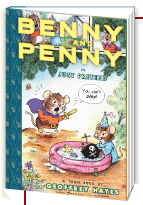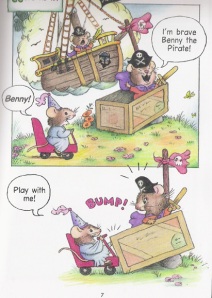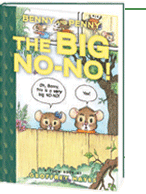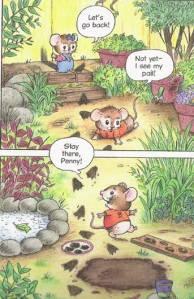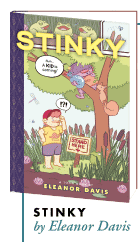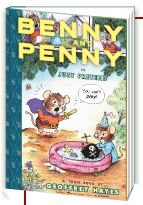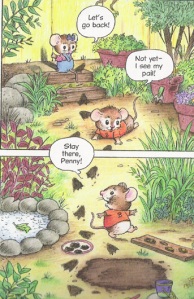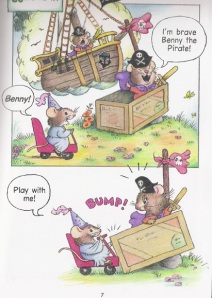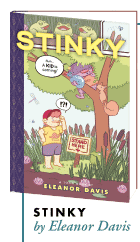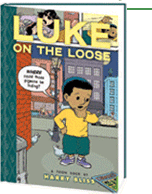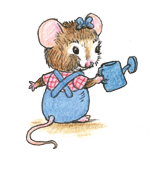I’m not exactly sure when Audrey Glassman Vernick became a blip on my radar, but suddenly she was blipping everywhere. I felt like one of those guys in the mission control tower, trying to determine if this green blip was a “friendly” or an incoming missile. Ultimately, I decided that Audrey was a rising star.
I had the chance to meet Audrey personally, as opposed to through her books, at the 2015 Princeton Children’s Book Festival (thank you, Alison Santos!). We were at a backyard gathering, tired and happy after a long day. I bravely introduced myself, and we enjoyed a brief, easy conversation. I liked her immediately.
Anyway, I invited Audrey over to my swanky blog for today’s conversation. Here she comes now . . .
AGV: Why, it is swanky!
JP: I know, thanks. It’s the Picasso poster, isn’t it? I saved it from college.
But that’s the definition of class. It’s not just a hand or flowers. It’s both! And thanks for having me.
Glad to have you. About a month ago I read a bunch of your books. I was especially taken by Edgar’s Second Word, illustrated by Priscilla Burris. I even wrote to tell you how much I loved it, calling it “a small masterpiece.” Do you remember your reply?
I hope my first response was thank you. And I suspect my quick follow up was that you were one of approximately six people who read that book.
Yes, you were gracious. But you also mentioned that I was one of the few people to have actually read it. Which just goes to show that this is a crazy business. Your book has so much heart. It’s expertly constructed, like a well-built cabinet. We learn Edgar’s first word, “NO!” early on, so there’s a built-in tension: What will his second word be? That curiosity keeps us turning the pages. I was worried that the second word might be a letdown, but you totally delivered.
Thank you! Tension (and the building up thereof) is my very least developed writer skill, so extra thank you!
I interviewed James Marshall back in the early 90s, and he maintained that a strong ending for a book was essential. I’ll always remember what he told me: “The ending is what people remember. If the book fizzles at the end, they remember the whole thing as a fizzled book. It’s important to have a very satisfying ending for the reader. They’ve entered a world and now they are leaving it.” Wise words, and again, I think you nailed it with Edgar’s Second Word.
Let’s stop right here so I can faint. James Marshall!
I know, I was bragging to impress you. He’s one of my children’s book heroes. I can vividly remember our conversation. Heck, I can remember picking up the phone. James was friendly, funny, genuine, completely unpretentious.
George and Martha are the two main loves of my life. They are quoted with solemnity in the Vernick home.
Do you have a favorite line?
A truth about me (which does not go over well with kids at school visits): I am unable to pick a favorite anything except sports team (Yankees). Unable. So I could write some great lines here but then, minutes later, I’d erase and replace. (It is not easy being me.) Also, you sort of have to be looking at George and Martha along with reading their words to get the full picture. All that said, an oft-repeated line that comes to mind (you won’t even believe how lame this is) is:
“Boo!” cried George.
“Have mercy!” screamed Martha.
Nice, subtle. His humor is always natural, never seems forced. You never get the feeling that Marshall is trying too hard.
The blog I had and still kind of have was in large part an homage to those two, about literary friendships.
Oh, nice idea. There’s Frog and Toad, of course. Do you know the book Patrick and Ted by Geoffrey Hayes? It’s pretty perfect.
I do not. But I shall seek it out. Pronto!
I blogged an appreciation of it a while back. Let me see, it’s around here somewhere. Here you go, click on the link.
Back to your question.
Wait, there was actually a question?
The ending! You asked about the ending! It was the first, and only, thing I knew about the book when I started writing it. I received an email from a college friend whose young not-book-loving son (Edgar!) sat through his mother’s read-aloud of Is Your Buffalo Ready for Kindergarten? and, at the end, said, “Again.” I shared that with my wise agent, Erin Murphy, who said, “Well obviously you’re going to use that in a book, right?”
Right.
I don’t know if this happens to you, but when a book fails to sell, fails to reach an audience, I tend to slowly, inexorably begin to think of it as a failed book. And by extension, I begin to see myself as a failed writer. Intellectually, I know that’s wrong, but that’s my reality. So that’s why I’m dwelling on Edgar a little bit here. I want to be sure that you know it’s a great blipping book!
That’s a very George-to-Martha thing to say (maybe not the blipping part). Thank you! I have my dysfunctions when it comes to this publishing business. I suffer some jealousies. I focus on benchmarks I have not achieved. But I am pleased to say that in this one particular case, I still really love this book. Priscilla Burris’ illustrations are unspeakably sweet and perfect.
Yes, she did a terrific job. The right tone.
And the people who read it respond so well to it. It just didn’t find its people. That happens. It wasn’t the first time it happened to me. A nice side note is that it was named a highly commended title by the Charlotte Zolotow Award for Outstanding Writing in a Picture Book.
First Grade Dropout, illustrated by my pal Matthew Cordell, turns on a lovely mistake. A boy absent-mindedly calls his teacher, “Mommy.” Where did that idea come from?
Some years I take part in Tara Lazar’s Picture Book Idea Month (PiBoIdMo), in which you try to come up with a picture book idea each day of the month. One day I wrote “kid calls teacher mommy,” something I know happens in my sister’s second-grade classroom with some frequency. (I’ve since learned it happens in nearly every classroom.)
Yes, it rings true. That’s probably why it’s funny.
 It sat on that list for years because it wasn’t a story yet, just an incident. One day I decided to give it a try. In my experience, you sometimes have to start writing a picture book to find the story. And that voice just came out. It happened again a few months ago, when I was looking for a follow-up to that book. I brainstormed ideas with my editor, but while we had fun and shared lots of embarrassing elementary-school memories, we didn’t hit upon anything usable for a book. Once I started writing, though, I found the idea for Second Grade Holdout, which is coming out next year (because Matt is F-A-S-T as well as fantastic).
It sat on that list for years because it wasn’t a story yet, just an incident. One day I decided to give it a try. In my experience, you sometimes have to start writing a picture book to find the story. And that voice just came out. It happened again a few months ago, when I was looking for a follow-up to that book. I brainstormed ideas with my editor, but while we had fun and shared lots of embarrassing elementary-school memories, we didn’t hit upon anything usable for a book. Once I started writing, though, I found the idea for Second Grade Holdout, which is coming out next year (because Matt is F-A-S-T as well as fantastic).
I am crazy about Matt. I once slept in his guest room. He even drove me to the airport. Strangely, Matt insisted on dropping me off sixteen hours early, which was confusing.
You are wise to be crazy about Matt. He’s kind and funny and so talented. Immensely likable.
Well, let’s not get carried away, Audrey. He’s okay. But I’ll be hog-tied if I let Cordell hijack this interview! So, yes, you discovered the idea for Holdout . . . through the act of writing. Jane Yolen’s famous “butt in chair” advice. How do you actually get work done, Audrey? Do you have a time clock where you punch in each morning? Or do you wait for inspiration?
Somewhere in the middle. I am not disciplined. With picture books, I write when inspiration strikes, but with novels I need to force myself to sit and write. And I have to come up with sad little bargains to keep myself in the chair, writing.
Such as?
I’m only allowed to sit in the comfy chair with the heated blanket when I’m working on a novel. And once I’m there, it’s still a whole bargaining thing. If you finish the chapter, you can shower. Or eat breakfast. Or walk the dog.
Oh, that poor dog. Getting back to James Marshall, you share a great trait with him. You’re funny. And even better, you are able to write funny, which is a distinct and rare talent. There’s never enough of that in children’s books. Children’s publishing went through a biblio-theraputic period where every picture book had to be about something important. Laughter lagged behind.
I nearly fainted from the first sentence here.
And I agree that there’s never enough funny. But there are so many more now than there used to be. The books that were considered funny when I was a kid and, for the most part, when my kids were little, were more amusing than genuinely funny. Lots of modern picture books are flat-out hilarious. It’s a really fun time to be writing them.
Can you name a few of your favorites?
See previous explanation of ever-changing favorites. That said, I believe the Pigeon books kind of burst the door open to a new kind of funny. Bob Shea’s books often crack me up and I have serious title-envy about his Unicorn Thinks He’s Pretty Great. Like debilitating jealousy.
Deborah Underwood’s Cat is a brilliant new character.
I really liked Ryan T. Higgins’ Mother Bruce and Julia Sarcone-Roach’s The Bear Ate Your Sandwich.
Good to know. I understand that 2016 is going to be a big year for you.
I have four books coming out.
Wow. Girl is on fire. You realize I kind of hate you now? A little.
I can both understand and accept that and will just quickly add that it’s possible I have four books coming out in six months -— the pub date for the last release of the year has not been set.
Shoot me now. I mean: I’m sooooo happy for you!!!!!
Aww!
I’m curious, how do you do it? I find that writing picture books can be so difficult. I’ve been seriously trying for the past year and everything comes out half-baked, half-finished, half-awful. There are times it feels like throwing darts in a darkened room. It’s so easy to go down the wrong path. I wonder if you can talk about your process a little bit. Do you begin with a character?
I write both fiction and nonfiction picture books, and for the nonfiction ones, I look for a subject, get obsessed, research and write.
Do you first clear the topic with an editor?
I float it more than clear it. Or maybe those are the same. I am not writing with a contract, to be clear.
And for your fiction titles?
Just about every one has been different. Sometimes, the title comes first and leads the way to the story. Teach Your Buffalo to Play Drums was the first of those for me. Once a whole first page came to me, unbidden:
“Zander was a monster. This wasn’t strange as his father was a monster. His mother too. Oddly, his sister was a fairy. And his dog was a skunk.”
That last sentence just killed me. (And then, as with many lines I love, I had to fight to keep it.) That’s from Unlike Other Monsters, coming out in June.
-
And his dog was a skunk. That’s a funny line. Comedy gold! Sometimes with the right sentence, even just a few words, or the right rhythm, a door seems to open. You can suddenly find your way in.
I don’t think any of my picture books has started with a character, which I didn’t realize until you asked. With novels, it’s always character. But it’s usually title/concept or incident that gets me started with picture books.
Getting back to what you said about going down the wrong path -— to me, that’s what is so great about picture books! If you do it in a picture book, you erase the last 100 words and go back to the fork. With a novel, hacking out 50 pages feels like pulling out a minor organ.
I maybe once cried when cutting 10,000 words from my book, Six Innings.
The first novel I wrote, Water Balloon, I wrote these extra 50 pages before the story really got going. I so wanted credit for those pages.
Even so, picture books have to be “just so.” You know? I feel like there’s more forgiveness in a longer work. More room to wander. With a picture book, basically 30 pages, there’s not a lot of space to get lost. That’s why I’ve concentrated on longer works, because I felt it gave me more control over my (and the book’s) fate.
I adore picture books. I love writing them. I love the very fact of them. I enjoy every step of picture book writing and revising. But getting a first draft of a novel done -— the avoidance I have to fight is embarrassing. I’m in that place now. At least ninety percent through a novel I’ve been working on for years. I am looking forward to being done but not to what I have to do to be done.
That’s how I feel about exercise.
Me too.
I could be wrong here, but it seems there are not many folks that are exclusively writers who have built a reputation in picture books. There’s Tony Johnston, Eve Bunting, Ruth Krauss, Mem Fox, Charlotte Zolotow. It’s not a long list. Mac Barnett, of course, is doing great work now. Though it was only last week when I first realized that he wrote Sam and Dave Dig a Hole. I had previously thought of it strictly as a Jon Klassen title.
Well, crap. I guess I knew that but I never knew it in words. Thanks.
You’re welcome! I like that you’re a big baseball fan. Where’d that come from?
When kids ask this at school visits I always give the super-articulate answer that goes something like, “It’s hard to say why you like what you like. For example, I love pizza. Why? Because it tastes good.” Note to self: Work on that response.
I was on a panel recently with a bunch of seasoned writers –- Todd Strasser, David Levithan, others –- and they all had such great, pithy answers to audience questions. I was like, “Damn, I have to raise my game.” The whole staring and stammering thing won’t cut it.
I don’t think anyone will ever say that about me. You know what impressed me about that Vernick? Pithy answers.
Pithy can feel too slick on some folks. I like your stammering authenticity.
My love of baseball -— sunny days (I will always take a day game over a night game); the fact that it’s a sport without a clock, with a lot of time for a mind to wander, to wonder, to draw connections; and it’s a sport with an immensely rich history (albeit one with very few women in it).
I associate baseball with my mom, who is still a huge fan at age 89. She taught me how to throw, how to catch. So there’s a lot of transference there: by loving baseball, I’m expressing love for my mother. Also, I loved playing, and still do. Now that I’m finished coaching (had a 15u travel team last season), I’ll probably return to a Senior Men’s Hardball team next spring. Read that as: Old guys clutching their hamstrings. We’re all still boys at heart. Did you ever get to play?
First I have to say I just love that, your connection to your mom there. Organized sports for girls didn’t exist when I was younger. I played softball at camp and was sometimes good. In my neighborhood, it was mostly punchball in the street. A neighborhood of girls. Seriously, I think there was only one boy and we were terrified of him because he once threw a firecracker at my sister.
He was probably terrified, too. Don’t we all throw firecrackers when we’re afraid? I know you are a Jersey Girl, and a mother, but outside of that, I don’t know much about your background.
Okay, first of all, no. I grew up in New York City -— in Queens. I’ve lived in NJ 19 years. Wow. That’s a long time. But I definitely do not identify as Jersey Girl. Strike that from the record!
Done. Both my parents were from Queens, so I like this better, anyway.
I live near the ocean. When I lived on eastern Long Island —- my home before this one, and Boston before that -— my house was a block from the Long Island Sound. I hope to always live near a big body of water. My present and future dogs probably hope so too.
Have you written a dog-and-ocean book yet?
I cannot sell a dog book. It kills me.
I hear hedgehogs are trending. Or was that five years ago? It’s hard to keep up.
I wrote literary short fiction for adults before writing for kids. It’s a very good way to learn to accept rejection.
So how did you get into children’s books?
It’s a sad story. You’ve been warned.
When I was in my early twenties, my mother was taking a children’s writing class at the New School in NYC and she sent the first novel she wrote to one publisher (Dutton) and it was accepted. She died two months later, a pedestrian on the sidewalk, hit by a car around the block from my childhood home.
 My family was reeling for years. And in that time, we had to work with my mother’s very patient editor. My mother hadn’t even received her editorial letter at the time of her death, so all the revision fell to us. As you might imagine, we didn’t want to change a single one of her words. So that was my first step, as the literary executor of her estate. (The book, The Morning Glory War, was published in 1990 and received a really nice review in the Sunday Times.)
My family was reeling for years. And in that time, we had to work with my mother’s very patient editor. My mother hadn’t even received her editorial letter at the time of her death, so all the revision fell to us. As you might imagine, we didn’t want to change a single one of her words. So that was my first step, as the literary executor of her estate. (The book, The Morning Glory War, was published in 1990 and received a really nice review in the Sunday Times.)
Wow. You must have taken a deep breath before typing that out. Like, “Okay, here goes, you asked.” I know that feeling, Audrey, since my oldest is a two-time cancer survivor. I’ve lost two brothers. These are not happy stories to tell at parties. Oftentimes, it’s easier not to get into it. And you’re right, it is sad, but it’s also an incredible story.
Yeah, as I wrote that out, I could see clearly that my family led me here.
Years later, I fell in love with the art of an outsider artist named Tim Brown, showed his art to one of my sisters, and she said that it belonged in a children’s book. Together, we wrote that book.
Which book is that?
Bark and Tim: A True Story of Friendship.
Hey, um, Audrey, this is nice and everything but . . . are you going to leave? I mean, ever? Or am I supposed to feed you now? I guess I have a pull-out couch . . .
Yeah, maybe tomorrow I’ll start pulling my stuff together. I could walk your dog. Do you have a dog?
Daisy. And two cats. And three kids. And four . . . well, it all stops at four. I don’t have four of anything.
I’m sure you have four readers of your blog!
Oh, dozens more. Dozens! We’re basically talking to ourselves here. It’s like the Cone of Silence in “Get Smart.” But before you go, is there anything you can share about your upcoming books?
Okay, since you asked:
The Kid from Diamond Street: The Extraordinary Story of Baseball Legend Edith Houghton, illustrated by Steven Salerno, nonfiction about a Philadelphia girl playing professional baseball from age 10.
I Won A What?, illustrated by Robert Neubecker, about a boy who hopes to win a goldfish and ends up with something a wee bit bigger. And better.
Unlike Other Monsters, illustrated by Colin Jack, with the opening page mentioned above. And a novel, Two Naomis, written with my dear friend Olugbemisola Rhuday Perkovich.
How did you co-author a book? It’s seems difficult, fraught with peril. How did you handle it?
I have co-authored four books. Two Naomis was the first novel. We each wrote from the point of view of our own Naomi. So my chapters were the even-numbered ones — individual writing of separate chapters. When I co-wrote picture books, first with my sister and most recently with Liz Garton Scanlon, we just back-and-forthed a lot. Both experiences were really freeing and so much easier than doing it alone.
So what’s for dinner?
Get out!
But before you go, by way of thank you, please accept this set of steak knives as a parting gift. I wish you all the luck in the world, Audrey. Keep up the great work.
Add a Comment

















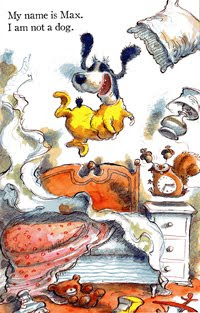
 Elephant and Piggie, 12 Books
Elephant and Piggie, 12 Books